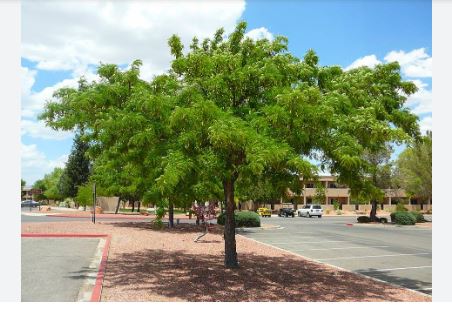
The honey locust, also known as the thorny locust or thorny honeylocust, is a deciduous tree in the family Fabaceae. Native to central North America, the Honey Locust can be found from Pennsylvania to Nebraska, and south to Texas and Mississippi where it is mostly found in the moist soil of river valleys. Honey locust trees are highly adaptable to different environments, and the species has been introduced worldwide. Outside its natural range it can be an aggressive, damaging invasive species.
A mature Honey Locust can reach heights of 60 to 80 feet. However, in some cases, especially with ideal growing conditions, they might grow even taller, sometimes up to 100 feet (30 meters). The spread or canopy width of the tree can be quite broad, often reaching 30 to 60 feet in diameter. The trunk can grow to a diameter of 2 to 3 feet, but exceptional specimens might have even larger trunks.
On younger Honey Locust trees, the bark is generally smooth and has a grayish to light brown color. As the tree matures, the bark develops into long, narrow ridges and can become deeply furrowed. The color darkens to a darker gray or brown, often with a reddish tint in the crevices of the bark. The wild form of Honey Locust is its large, branched thorns which can grow directly on the trunk and branches. These thorns can be several inches long, very sharp, and are often red or brown.
The leaves are pinnately compound or bipinnately compound, meaning they are made up of many small leaflets on a single leaf stalk (pinnate), or the leaflets themselves are further divided (bipinnate). Each compound leaf can have between 18 to 28 leaflets. They turn a darker green as the season progresses. Before falling, the leaves can turn a brilliant yellow, although this can be less pronounced in some trees or in warmer climates where the fall color change might not be as vivid.
The Honey Locust typically blooms in late spring to early summer, around May to June, depending on the local climate. The flowers are small, greenish-yellow to white, and not particularly showy when viewed individually. However, they can be quite fragrant. They appear in clusters, often hanging in racemes or spikes.
The tree is dioecious, meaning there are male and female trees. Male flowers grow in denser, more elongated clusters, while female flowers are less numerous and often in shorter spikes. Following pollination, the female trees produce long, flat, twisted seed pods. When mature, they are a dark reddish-brown color.
Inside these pods are numerous flat, oval seeds surrounded by a sweet, sticky pulp, which is where the tree gets its “honey” name. This pulp is edible and has a sweet taste, which is why it’s attractive to wildlife and was used by humans historically.
The Honey Locust is generally considered to have a medium to fast growth rate. Under optimal conditions, it can grow more than 24 inches (60 cm) per year. A Honey Locust tree typically lives for about 100 to 150 years. Some trees might live longer with ideal care and in favorable conditions, though urban environments with pollution, soil compaction, and other stresses can significantly reduce this lifespan.
There are several cultivated varieties that have been developed for ornamental use, focusing on characteristics like lack of thorns, specific growth habits, or foliage color.

Cultivation
- It’s adaptable to a wide range of soil types, including clay, loam, or sandy soils, but prefers well-drained soil. It can tolerate alkaline, acidic, or neutral pH levels.
- Young trees need regular watering to establish, especially during dry periods. Once established, they are quite drought-resistant but will benefit from occasional deep watering during extended dry spells.
- Prune in late winter or early spring when the tree is dormant. Remove dead, diseased, or crossing branches. Pruning can also help shape the tree when young to promote a strong structure, although Honey Locusts naturally develop a good form.
- While relatively pest-resistant, watch for issues like leaf spot, canker, or insects like the mimosa webworm or spider mites. Integrated pest management practices should be employed, using chemical treatments only when necessary.
Ecological and Landscape Uses
- The pods can be used as fodder for livestock.
- The thornless varieties are popular in urban settings because they tolerate pollution, compacted soil, and drought well, making them suitable for street trees.
- The wood of the Honey Locust is durable, hard, and rot-resistant, used for fence posts, furniture, and pallets.
- It’s a legume, which means it can fix nitrogen in the soil, improving soil fertility. This trait makes it beneficial in reforestation and soil rehabilitation projects.
Cultivars
| Cultivar | Thornless | Pod Production | Growth Habit | Color Features | Other Notes |
|---|---|---|---|---|---|
| Shademaster | Yes | Almost none | Upright, ascending | Green foliage, yellow fall | Vigorous growth |
| Skyline | Yes | Few | Pyramidal | Good yellow fall color | Strong central leader |
| Sunburst | Yes | Nearly seedless | Spreading | Yellow new growth | Bright foliage in spring |
| Imperial | Yes | Almost none | Compact, rounded | Green foliage | Suitable for smaller spaces |
| Moraine | Yes | Few | Vase-shaped | Green foliage | One of the first thornless cultivars |
| Ruby Lace | No | Normal | Spreading | Reddish-purple new growth | Less common, some thorns |
| Northern Acclaim | Yes | Few | Upright | Green, long leaf retention | Cold hardy |
| Street Keeper | Yes | Almost none | Narrow, upright | Green foliage | Suitable for street planting |
| Summer Lace | Yes | Few | Spreading | Fine-textured foliage | Tolerant to urban conditions |